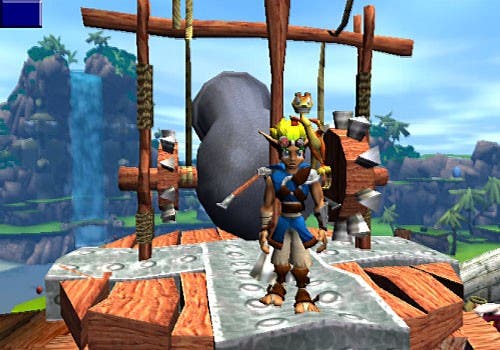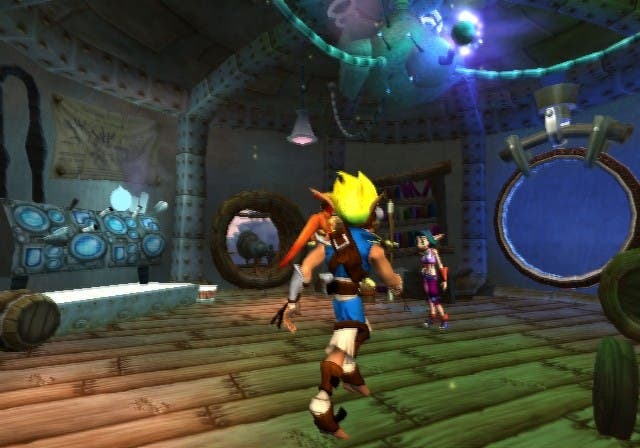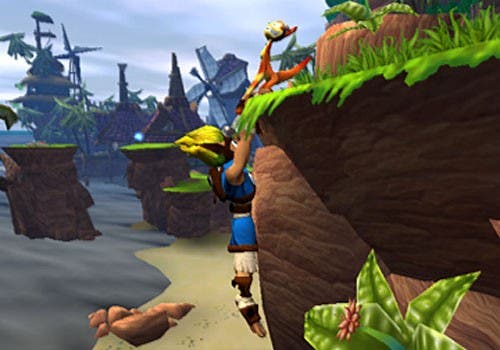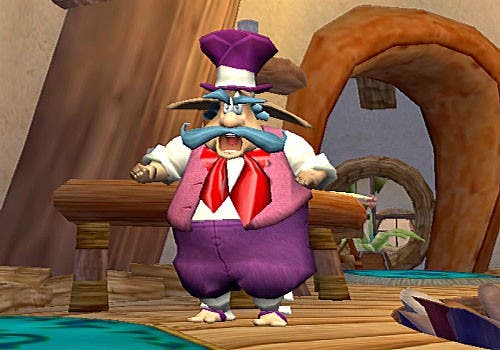Jak & Daxter : The Precursor Legacy
Review - a powerful amalgamation of elements created to give Banjo Kazooie types a definitive article

A Bandicoot
That's right, a bleedin' bandicoot. What the hell were they thinking? Dubbed the PlayStation's answer to Mario 64, Crash Bandicoot was an enjoyable romp walled in by, well, walls. It lacked the freedom, familiarity and charm of Mario 64 and although it spawned a number of sequels, it never really won my heart. I did predict big things for developer Naughty Dog however… And lo, with Jak & Daxter they have truly delivered. Although the game will come across as too cute for some, this seamless, eclectic blend of action, adventure and comedy served up on a single DVD is a better game than Mario 64, and probably the pinnacle of platform gaming as it stands. J&D rarely lets up throughout its ten hours or so of gameplay, and if you enjoyed the likes of Donkey Kong, Mario and Crash, this gem of a game deserves to find its way into your collection. The story concerns the plight of Jak and his sidekick Daxter. After disobeying Chief Samos' orders and sneaking off to Misty Island, Daxter falls into a vat of Dark Eco and turns into a small fuzzy animal reminiscent of Timone from The Lion King. After liasing with the Chief, Jak and Daxter set off to find Gol, the Dark Eco expert, who Samos believes can undo Daxter's transformation. The only problem is that Gol lives miles away, and between our heroes and his refuge lies Fire Canyon. Never fear though, because the Chief's saucy-looking daughter Keira has an anti-gravity Zoomer, which can cross the lava if you find 20 power cells to fuel its shields. As it turns out, that's the least of the duo's worries.

Gimme Fuel...
And so begins the quest for 101 power cells, spread across a number of areas and hidden behind a wide variety of tasks and NPCs. The word 'levels' isn't really appropriate in this game, because Jak & Daxter's world is practically seamless. The game is made up of several big 'hubs', and at the centre of each is a Sage's hut and village. Your chief is the local Sage and along with his village you can initially find your way around Geyser Rock, the 'tutorial' area of the game with its four power cells to uncover, Sentinel Beach, a larger area with more cells to find and a couple of other locations. Certain missions - usually discovered either by accident or dealt out by Samos, Keira or one of the other NPCs you happen to run into - unlock paths to new areas of the game. For instance, help the local fisherman to catch 200lbs of fish and he'll let you use his speedboat to go to Misty Island. Once there you have to complete a number of objectives, the most pressing of which (although you can complete them in any order) is the matter of the Lurkers bombarding a Dark Eco silo with explosives to try and get at its contents. Each area has between two and eight power cells to collect, and you can keep up with your totals (and perhaps pick up a couple of hints) on the pause screen. But what is Eco? And why did it do weird things to Daxter? In ancient times, two forms of Eco, Dark and Light, became prevalent in the world and the race of Precursors tried to control them and create a utopian society. Unfortunately Dark Eco corrupted and the Precursors fell from grace, pooling Dark Eco into great silos beneath the planet surface so that never again would it corrupt and destroy in the manner that it had. Unfortunately, the race of Lurkers led by a mysterious force is trying to unlock Dark Eco and use it for their own gain. Demonic monsters, from hostile crustaceans to swooping spiders and angry vermin populate the land, and it doesn't help that the Lurkers are constantly trying to put pay to Jak & Daxter with explosive traps and ambushes. Light Eco, however, can be harnessed for plenty of useful means. One of our heroes' earliest missions is to re-establish the stream of Eco to the village power station, and balls of Light Eco can be found all over the place, giving Jak a temporary speed boost and the ability to open the doors of Precursors temples and power-up stashes.

Mesmerizing
J&D is visually spectacular from the get go, far more detailed than any other PlayStation 2 game to date, with phenomenal texturing, lighting and modelling. Running at a cool 60 frames per second thanks to the game's advanced display settings, there's little evidence of tearing or carelessness. PS2 games often appear to be coming apart at the seams, but Jak & Daxter bucks the trend. Jak even looks eerily similar to Tidus from Final Fantasy X with his fiery Dragonball-style locks and tight-fitting blue clothing, while Daxter is a naked marsupial by all accounts. The character animation is of a constant high standard, whether Jak is running along with Daxter bobbing on his shoulder, hanging from a ledge (a position from which he can leap to the ground or yank himself up) or doing a rolling jump to reach distant platforms. Whenever the player uncovers a power cell, a quick jingle is played as the game saves while Jak & Daxter party on-screen, Jak in a fairly reserved manner and Daxter doing everything from break-dancing to slam-dunking. The most amazing thing about Jak & Daxter though is the complete absence of load times and fogging. You can see everything as far as the eye can see, and generally you can go there. This is what gives J&D its seamless feel - it's a game without many of the assumed parameters of one, and all the more immersive for it. It's also nothing if not scenic. The village people live in large round huts which are fully furnished for the purposes of the game, and like every other area of the game sumptuously detailed right down to the finest point. The screenshots really do not do this game justice. As you chisel your way through Naughty Dog's adventure you will observe volcanic boulders perched atop the smouldering remains of a dustcart, complete with heat haze effects beyond anything else on the system; enormous underground chasms with flaming torches, lava pools and rolling minecarts as far as the eye can see, and real-time lighting accentuated by the startling realisation that J&D comes complete with its own weather cycles. Come rain or shine, our heroes can plough through the Precursor's Legacy, from a sunken Atlantis-style civilization to the heart of a volcano…

Majestic
A feast for the eyes Jak & Daxter certainly is, but the game's modest soundtrack and precise control system help to make it a pleasurable experience. The controls are fairly basic but get the job done, with jump bound to X (tap it once then once again in midair to do a double-jump), and O handling Jak's spin-kick and NPC interaction and acting as a general 'use' key. Press the square button and Jak performs a dash-punch knocking out his enemies or, if you press it in midair, he comes hurtling down in the specified cursor direction, allowing you to break into certain crates. Which is handy, because there are a lot of crates in Jak & Daxter. Some contain health, some contain scout flies (of which each area in the game has seven to collect, rewarding you with a power cell should you find them all) and others contain Precursor Orbs. Now, a lot of the story concerns Precursor relics and keeping them away from the Lurkers, but one aspect of the Precursor's Legacy left almost entirely out in the open is these Orbs. There are 2,000 of them in the game, and you find them all over the place. You can trade them with certain NPCs for power cells - the lowest common denominator as far as your objectives are concerned - and they can also be found in crates which can only be opened by tricking the Lurkers into firing explosives at them, or by collecting orange blobs and shooting them yourself. The ability to fire isn't something you wield from the get-go, however, and this is one of the founding points behind Jak & Daxter: superb game design. For starters, there is no 'lives' system. You lose all three chunks of your health before you can replenish them? After a quick death animation and optional Daxter comment you find yourself at the start of the last section of the area you were working on, be that the Sentinel Beach, Lava Tube or what-have-you. Frail though you are, the developers obviously saw no benefit in piling the pressure on you to perform, and this game is better for it. Not content with that, if you happen to collect a power cell from one area, there's no prising that from you, even if you 'die' immediately. The same goes for multi-part objectives which have you performing several tasks. You rarely have to repeat difficult processes once you've achieved an obvious objective. It's a reward structure that deserves mimicry.
Conclusion
Jak & Daxter is a decent length for a videogame at roughly ten hours, and it boasts an enormous number of hugely varied tasks to complete and beautiful sights to see. Capped off with an elegant control system and intelligent game design, this is the platformer to bury both mediocre rivals like Banjo Kazooie and old classics like Mario 64. It doesn't really innovate to any great degree, but it combines so many of the right elements of gaming that to leave it out of your collection would be to do yourself wrong. All glory to the inevitable sequel, and since I'm through lumping praise onto this game, get off your behind and buy it.


